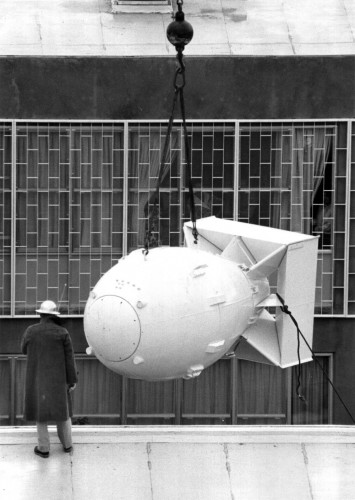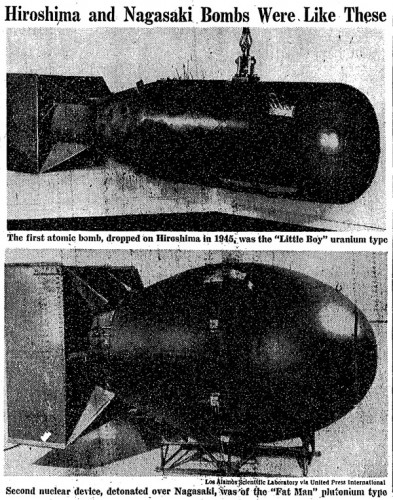Old bomb casings are just that perfect outdoor arrangement for your museum about war. And hey, let’s be honest: we’ve got quite a few of them left over from the Cold War. Might as well use them for something!
Today’s photo of the week is the installation of a Fat Man casing at the Los Alamos Science Museum:1
I love this photo for it’s wonderful contrast of tone, and the man-meets-bomb aspect. It also highlights how physically large the Fat Man bomb was, something that can get lost when you see photos of it in isolation. I’m not sure if the bomb is literally whitewashed here, or if that’s just how it looks in a black and white photo, but that’s a nice aspect, too.
Some more thoughts on atomic bomb casings and their public history follow after the jump.
I’m not sure exactly when this photo was taken — its record at NARA didn’t have a lot of information on it. But the casings of Fat Man and Little Boy were declassified for the first time in 1960. Note that this was considerably later than the basic mechanisms of their internal workings: the basic gun-type design was discussed in the Smyth Report, and the basic implosion design was declassified in 1951 as part of the Rosenberg trial. Why 1960? No particular reason, apparently. The date they were officially declassified was December 7, the 19th anniversary of Pearl Harbor, but the Atomic Energy Commission claimed it was a coincidence:
At first, the argument against declassification was “we don’t want to tell the Russians any more than we have to.” In 1949, after the Russians exploded this argument by exploding their own bomb, requests for pictures were refused on the ground of “why tell the others?” More recently, classification became a matter of high policy rather than military necessity. While the AEC and Pentagon favored release, the State Department argued that the photos could be used in Communist propaganda, especially in Japan during the fight for ratification of the U.S. security pact. Then came the U.S. election campaign and the Japanese elections. Next, in Geneva, the nuclear-test-ban talks recessed. Last week, an AEC official said: “It was decided that no adverse effect or harmful propaganda could result at this late state”—which, he added, just happened to coincide with Pearl Harbor Day.2
These days, many of the bomb casings are apparently being replaced with replicas. Why? Because pesky folks like John Coster-Mullen have found ways to wring secrets out of them, despite them having been declassified over fifty years ago. John — who you probably know from his 2008 New Yorker profile, if not his self-published book, Atom Bombs (which any self-respecting nuclear nerd should have in their library) — went around to a number of these casings and snaked cameras inside of them, getting their exact interior dimensions and a load of other information. From these he was able to work backwards with a lot of other information he got from the archives and produce rather exact measurements for the World War II weapons. And that, understandably, made the National Nuclear Security Administration and other such folks a little uncomfortable (and hey, it’s their job to be made uncomfortable by this sort of thing).
I’m not sure if the Fat Man casing that was taken through a Los Alamos car wash is the same as the one in the top photo, or a replica, or an entirely different bomb altogether. They’re hard to keep track of.
Some nuclear secrecy scuttlebutt: I heard, by means of someone at the Smithsonian, that the DOE (or whomever) have occasionally come around to the various museums on the mall to “sanitize” bomb casings on display over the years — sanding of bits of them, sanding out the interior, etc. Not surprising that they might do that periodically. But here’s the kicker: apparently, when said agencies want to be discreet, they show up in an Entenmann’s truck. Let that image roll around in your mind a bit: donuts of declassification.
Truth? Fiction? A one-off deal? I don’t know, and my source emphasized that this was not first-hand knowledge on his part. But it’s too amusing of a story to not to share, even with the reservations.
- Source: National Archives and Records Administration, Still Pictures Branch, 454-RF-30. [↩]
- “D Plus 15 Years; Now It Can Be Told,” Newsweek (19 December 1960), 60-61. [↩]





Coster-Mullen is also featured in this short 2011 documentary – http://motherboard.vice.com/2011/3/30/the-atomic-trucker-how-a-truck-driver-rebuilt-the-atomic-bomb–2.
I think that this is not the bomb casing being installed at the Bradbury Science Museum in downtown Los Alamos, but rather in the courtyard of one of the buldings on the west side of Diamond Drive, part of a complex that once housed weapons physics groups at the Lab. The window style and the white casing are the giveaway.
The courtyard held several painted-white bomb casings, including a Little Boy casing. I think these casings eventually made their way to the Bradbury museum. I am also thinking that this was the original location of the museum, before it was named for Norris Bradbury, but I could be wrong on that.
The date, then, would be before the museum was located downtown, probably in the mid-to-late seventies.
Cheryl: That sounds plausible to me!
[…] That’s the kicker. If you knew that “Trinity” was a sphere, you might ask, why make a gun into a sphere? Unless it wasn’t a gun. Which, as we now know, it wasn’t. (This is why photos of the “Fat Man” and “Little Boy” casings were kept secret for so long.) […]